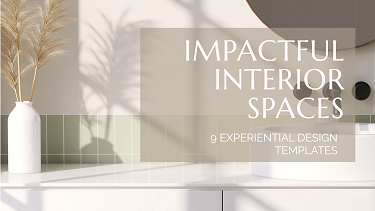- Beyond Aesthetics Playbook
- Posts
- The Role of Culture in Interior Design
The Role of Culture in Interior Design
Explore how cultural storytelling in interior design shapes spaces with colours, patterns, and traditions to create a home that reflects your unique story.

Have you ever walked into a room and immediately felt at home? Or maybe you’ve entered a space that seemed so foreign, that you could tell it was inspired by a culture different from your own.
Culture is the secret ingredient affecting how a space feels, looks, and functions.
Embracing cultural influences in your interior design project can help you create a space that reflects your personality. This approach is called cultural storytelling in interior design.
It's all about incorporating aspects that reflect your heritage and personal experiences into your home.
But how exactly does culture influence interior design? And how can you use it to create a space that feels meaningful? Let’s explore the powerful connection between culture and interior design and how it can enhance your living spaces.
What Is Cultural Storytelling in Interior Design?
Cultural storytelling in interior design is the process of using colours, patterns, textures, and decor to tell a story. This could be about a specific culture or personal experience.
Cultural storytelling is more than decoration - it is about weaving design elements to represent a unique heritage, tradition, or way of life.
For example, a home inspired by Japanese culture might feature clean lines, natural materials like bamboo, and minimalistic, low-level furniture to project calm and harmony.
Meanwhile, a Moroccan-inspired space might have bold geometric patterns, rich jewel tones, and ornate lanterns that reflect the vibrancy of North African design.
By incorporating elements from different cultures into your space, you can create a beautiful and deeply personal interior design narrative.
How Culture Shapes Interior Design
Culture influences interior design in several ways, from the colours we choose to how we arrange furniture. Here are some of the most impactful ways culture shapes the spaces we live in:
1. Colour psychology and symbolism
Colour plays a major role in defining culture in interior design. Different cultures attach different meanings to colours, which can impact how a space feels.
In Chinese culture, red symbolizes luck and prosperity. This is why it's often used in festive decor.
Scandinavian design leans toward neutral tones like whites, greys, and soft blues to create a sense of simplicity and cosiness.
Mediterranean interiors often use warm earth tones like terracotta, ochre, and deep blues, reflecting the natural landscapes of the region.
When designing your space, think about how different colours make you feel. Also, consider how they align with your personal experiences or cultural background.
2. Patterns and textiles with cultural roots
Many cultures have distinct patterns and textiles that have been passed down for generations. These designs can add depth and personality to your space.
Ikat and batik textiles, often seen in Southeast Asian and African cultures, can bring bold, handcrafted beauty to a room.
Persian rugs add an air of tradition and craftsmanship to any space, often becoming the centrepiece of a room.
Native American and Southwestern designs incorporate geometric patterns that evoke a deep connection to the land.
Adding culturally significant textiles to your decor is an easy way to bring cultural storytelling in interior design into your home.
3. Furniture styles and layouts
Different cultures have distinct approaches to furniture and spatial arrangements.
Japanese interiors favour low furniture, such as floor cushions and low tables, promoting a sense of groundedness and mindfulness.
In contrast, traditional European interiors often feature elaborate, high-backed chairs and ornate wooden furniture, emphasizing grandeur and formality.
Middle Eastern homes often have large seating areas with plush cushions, encouraging relaxation and hospitality.
Understanding these influences can help you create an interior design narrative that suits both your aesthetic preferences and lifestyle.
4. Architectural elements and materials
The materials and architectural details used in a home often reflect cultural traditions and regional resources.
Mediterranean homes feature stucco walls, terracotta tiles, and arched doorways.
Scandinavian design embraces natural wood, stone, and large windows to bring in light.
Indian interiors use carved wooden doors, intricate lattice screens, and vibrant hand-painted tiles.
If you want to embrace culture in interior design, incorporating materials and architectural elements from a specific region can create an immersive experience in your space.
How to Incorporate Cultural Influences Into Your Space
Now that you understand the role of culture in interior design, here are some practical ways to bring cultural storytelling into your home:
1. Start with what inspires you
Think about the cultures that resonate with you. Maybe it's a place you've travelled to, your family’s heritage, or a design style that speaks to your soul. Use this as a starting point for your design choices.
2. Mix traditional and modern elements
Blending cultural influences with contemporary design keeps your space feeling fresh and balanced. A traditional Moroccan rug paired with sleek modern furniture can create a stunning contrast.
3. Use art and decor to tell a story
Wall art, sculptures, and handcrafted pieces can add depth to your interior design narrative. Displaying cultural artefacts or handmade crafts can make your space feel personal and meaningful.
4. Pay attention to lighting
Lighting is an essential part of cultural storytelling in interior design. For example:
Japanese lanterns create a warm, soft glow that enhances tranquillity.
Moroccan lanterns with intricate metalwork cast beautiful shadows, adding drama to a room.
Scandinavian homes often use oversized pendant lights to brighten up long winter months.
Choosing lighting that reflects cultural traditions can enhance the atmosphere of your home.
5. Embrace cultural rituals in design
Beyond aesthetics, interior design is also about how you experience the space. Many cultures incorporate rituals into their home environments, which can inspire your own design choices.
Feng Shui, a Chinese philosophy, focuses on arranging furniture to promote positive energy.
Hygge, a Danish concept, emphasizes creating cosy and inviting spaces to foster happiness.
Wabi-sabi, a Japanese design philosophy, embraces imperfection and natural beauty.
Integrating these ideas into your space can enhance the emotional connection you feel to your home.
Why Cultural Storytelling Matters in Interior Design
At the heart of cultural storytelling in interior design is the idea that a room should be more than just a visually pleasing space. It should be a reflection of your identity, history, and experiences.
By thoughtfully incorporating cultural elements into your design, you can create a space that tells a story, feels authentic, and provides a deep sense of comfort and belonging.
So whether it is the simplicity of Scandinavian interiors, the bold colours of African design, or the timeless elegance of French decor, embracing culture in interior design allows you to create unique spaces that reflect your personality.
What story will your space tell?
Catch up with our latest blogs
Thanks for reading!
We’d love to hear from you. Please share your feedback, thoughts and suggestions by replying to this email.
If you are considering an interior design project, I’m offering a FREE 30-minute online consultation throughout March. Book your meeting here.
We are working to grow our reach. Please consider subscribing here and sharing this newsletter with your networks.
Stay inspired!




Reply